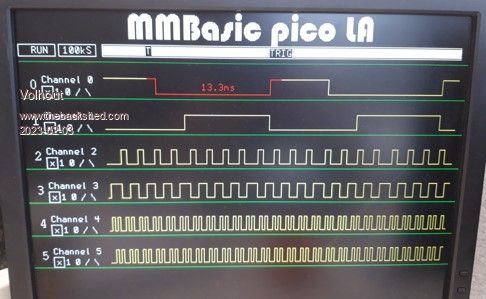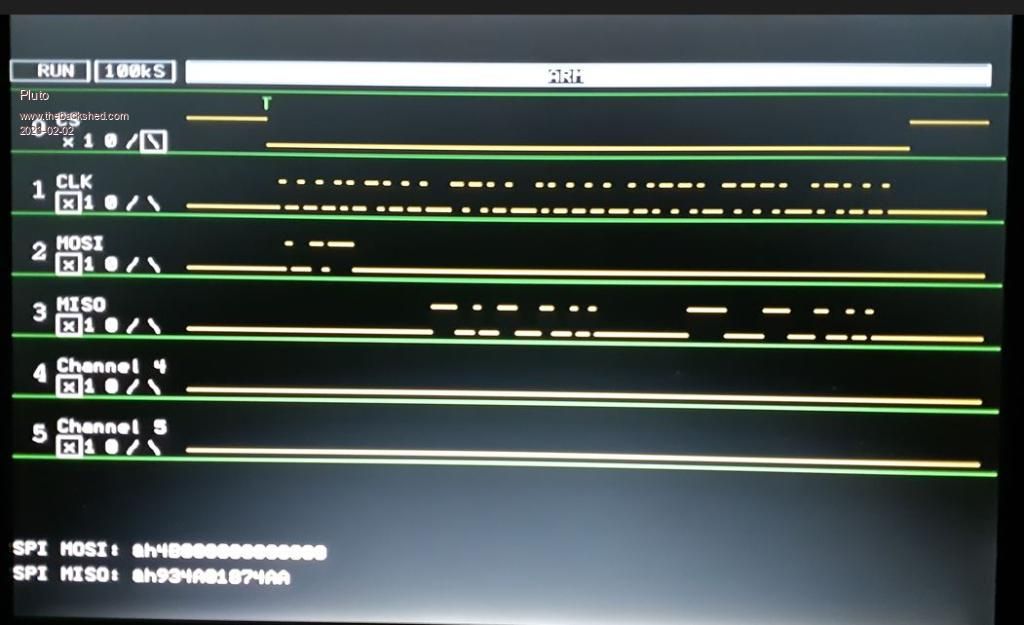MMBasic Pico Logic Analyser
An inexpensive logic analyswer based on a PicomiteVGA
| IanT | 03/02/2023 13:54:36 |
| 2147 forum posts 222 photos | WARNING - Look away now Dave! As some here will know, I've been a user of 'Micromites' for some time now, as in my view they are easier to set-up and debug for many embedded applications than the better known alternatives. My early ones used a 28pin PIC32 chip. Micromites all run a modern version of BASIC, known as Micromite Basic (MMB). Most recently, I've been using 'Picomites' - Mites based on the RPi Pico, which give a very powerful, inexpensive and easy-to-use controller. Another version of the Picomite (PicomiteVGA) uses the second CPU (and one PIO) to deliver 16 colour VGA graphics, whilst also delivering full compute power from the other CPU (e.g. a 'Home' computer) I'm busy building two of these PicomiteVGA computers. One for myself and one for my Grandson, mainly as a fun way to get him into computers and also something that can play simple games (without needing Internet access). I happen to have two old VGA monitors and PS2 keyboards (but I think you can still buy them) - so the cost will be very low - about £20 each in my case. However, the clever people who have made all this possible have been busy exploring ways to build a PIO (Programmable I/O) 'assembler' into (Pico) MMB and have been making very good progress in this area. The Pico has two PIO channels that are very fast and can operate independantly of the two ARM CPUs. So once you've set them up, they can race away, regardless of what the main processors are up to. Recently, one of the Programmers behind the PIO effort has developed an 8 Channel Logic Analyser that is starting to look very useable. Enough so that I'm thinking of building another PicomiteVGA as a dedicated LA system ( I ordered x 5 PMVGA PCBs) - the cost of the other components being minimal, with the software being free of course. I'm not aware of anything that provides this level of functionality at this price point, so I thought it was worth a mention here. Please don't ask me too many technical questions at this point, I'm familiar with 'Mites' in general but not the PIO aspects at this time. Fortunately, the LA coding has been done for us and it's a simple cut and paste job to load it. The PMVGA also has a filing system (SD card or Flash) so you can data-log too (if you are cleverer than me). More info here: Regards,
IanT
Edited By IanT on 03/02/2023 13:55:57 Edited By IanT on 03/02/2023 13:58:31 |
| Michael Gilligan | 03/02/2023 16:14:30 |
23121 forum posts 1360 photos | Very interesting post, Ian … Thanks MichaelG. |
| IanT | 07/02/2023 11:44:07 |
| 2147 forum posts 222 photos | I'm going to make another update to this thread because I'm really impressed by what's been done here and the fact that none of this would have been possible just a few years ago. I could never have afforded a Logic Analyser for the very occessional use I might put it too. I dabble in electronics but it's certainly not my main hobby. The Pico LA has grown out of a collaboration between a few enthusiasts in UK, Holland and Australia. It started as a 'Tutorial' to help forum members understand how the Pico PIOs worked. It was picked up by the lead developer who added to MMB to enable access to the PIOs within MMB. A series of exercises were built to help users gain experience and within a few weeks this software started to emerge. A quite remarkable achievement from a few clever people scattered around the world. For anyone who doubts the capability of this little device - it is capable of sampling upto 42 msps (million samples per second) - so a bit faster than my Z80 based Nascom 2 could manage. I have some older DROs I'd like to hook up to an external display (and be able to programme the output) and I think this will give me the means to do so. In the meanwhile, a few early PicoLA routines are already emerging for anyone who needs to look at I2C or SPI devices - in principle any serial communications. Anyway - I'll update this thread from time to time as I think it has a lot of potential and hopefully will be of use to folk who might also "dabble" in these things like myself. Regards,
IanT |
| John Olsen | 08/02/2023 01:02:42 |
| 1294 forum posts 108 photos 1 articles | Funnily enough I once had an HP logic analyser given to me, but it had no probes, and I never managed to source any or find out what was in them. So I ended up giving it to someone who had a collection of HP stuff. But now I have one of the Kingst USB logic analysers, and it works fine. Mine is the cheapest model. You can get their software and run it in a demo mode to see how it looks. I have no connection with them, other than as a satisfied customer. John |
| IanT | 08/02/2023 09:57:42 |
| 2147 forum posts 222 photos | I wasn't aware of these devices John but they do look very capable and not expensive at £80. A basic (stripped down) PicomiteVGA can be built for the cost of the Pico, a few resistors and a VGA socket. You don't need the PS2 keyboard as you can use the serial console. For a one-off (quick) fault find, you could just put it together on a breadboard for less than £10. You'd need a VGA monitor for display of course but some new monitors still support VGA - or you can buy 'refurbished' ones for under £30. I have several sitting unused under my desk currently. I am already building two 'Peter Mather' based PMVAGs. Using his gerbers I ordered five boards from JCLPCB, which cost me £16.58 (inc shipping & taxes) so I have three spare PCBs. Peters' design includes an RTC, Audio, SD Card and PS2 keyboard support, a 40pin I/O connector and two Pico 'expansion' slots but most of it is optional - you don't need to populate all of it to have a working device. In my case I want to understand how to access the PIOs and use them within my own MMB applications. All of the LA code is open to view, use parts and alter to suit my specific needs - a large leg-up. I can read serial and parallel devices and have programmed responses. It's just limited by my imagination and (in)ability to get off my butt and actually do it! Regards,
IanT
|
Please login to post a reply.
Want the latest issue of Model Engineer or Model Engineers' Workshop? Use our magazine locator links to find your nearest stockist!
Sign up to our newsletter and get a free digital issue.
You can unsubscribe at anytime. View our privacy policy at www.mortons.co.uk/privacy
- *Oct 2023: FORUM MIGRATION TIMELINE*
05/10/2023 07:57:11 - Making ER11 collet chuck
05/10/2023 07:56:24 - What did you do today? 2023
05/10/2023 07:25:01 - Orrery
05/10/2023 06:00:41 - Wera hand-tools
05/10/2023 05:47:07 - New member
05/10/2023 04:40:11 - Problems with external pot on at1 vfd
05/10/2023 00:06:32 - Drain plug
04/10/2023 23:36:17 - digi phase converter for 10 machines.....
04/10/2023 23:13:48 - Winter Storage Of Locomotives
04/10/2023 21:02:11 - More Latest Posts...
- View All Topics
- Reeves** - Rebuilt Royal Scot by Martin Evans
by John Broughton
£300.00 - BRITANNIA 5" GAUGE James Perrier
by Jon Seabright 1
£2,500.00 - Drill Grinder - for restoration
by Nigel Graham 2
£0.00 - WARCO WM18 MILLING MACHINE
by Alex Chudley
£1,200.00 - MYFORD SUPER 7 LATHE
by Alex Chudley
£2,000.00 - More "For Sale" Ads...
- D1-3 backplate
by Michael Horley
Price Not Specified - fixed steady for a Colchester bantam mark1 800
by George Jervis
Price Not Specified - lbsc pansy
by JACK SIDEBOTHAM
Price Not Specified - Pratt Burnerd multifit chuck key.
by Tim Riome
Price Not Specified - BANDSAW BLADE WELDER
by HUGH
Price Not Specified - More "Wanted" Ads...
Do you want to contact the Model Engineer and Model Engineers' Workshop team?
You can contact us by phone, mail or email about the magazines including becoming a contributor, submitting reader's letters or making queries about articles. You can also get in touch about this website, advertising or other general issues.
Click THIS LINK for full contact details.
For subscription issues please see THIS LINK.
Model Engineer Magazine
- Percival Marshall
- M.E. History
- LittleLEC
- M.E. Clock
ME Workshop
- An Adcock
- & Shipley
- Horizontal
- Mill
Subscribe Now
- Great savings
- Delivered to your door
Pre-order your copy!
- Delivered to your doorstep!
- Free UK delivery!














 Register
Register Log-in
Log-in


